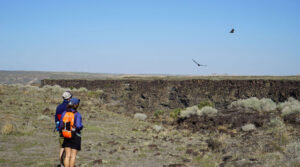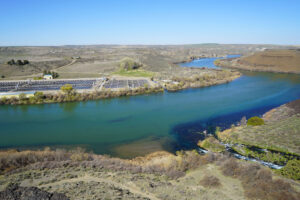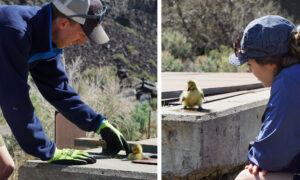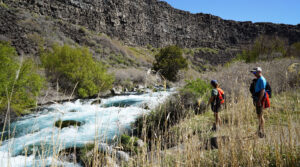Flowing through a basalt canyon and tumbling over rapids and waterfalls on its journey to the Snake River, Box Canyon Springs gleams turquoise in Idaho’s sunshine. This stunning waterway, located in Earl M. Hardy Box Canyon Springs Nature Preserve (one of the units of Thousand Springs State Park), is a reminder of the importance of clean water to the future of the Magic Valley. ICL is on a mission to protect the Snake River and its aquifer from harmful contamination and mismanagement. Exploring the wild waters and unique geological features of the Magic Valley helps us see the Snake River as more than just a working river and appreciate the essential resources, recreational opportunities, and wildlife habitat the river provides.
Home to one of the most impressive, accessible, and stunning waterfalls in the state, Box Canyon Springs is a perfect spring adventure to experience the magic of southern Idaho. Our hike in the canyon inspired us to continue working towards a safe, swimmable, and fishable Snake River.
Views from the canyon rim

A day trip to Box Canyon Springs packs a punch with its dramatic views, wildlife sightings, and misty riverside hiking. The trailhead was easy to find on the GPS and was well signed from the highway. We drove past the gate into the fee area and left our vehicles at the parking lot at the overlook. The view stunned us from the first peek over the horizon of the canyon. Bright blue pools at the amphitheatre-like headwall reflected the spring sunlight. We set off along the canyon rim, hiking out to the confluence of Box Canyon Springs and the Snake River. Lizards darted over the black volcanic rocks and yellow-bellied marmots watched us from behind sagebrush camouflage. Vultures soared overhead in the blue skies above the cliffs.
Box Canyon is carved out of basalt and contains the 11th-largest spring in the United States, leading some to believe that the canyon and its steep amphitheater-shaped headwall might have been formed by erosion from the spring itself. However, researchers have now conclusively shown that the canyon was formed by a megaflood around 45,000 years ago. This megaflood is estimated to have had flows greater than 7,800 cubic feet per second, which is greater than the mean discharge of the entire Snake River in this area!

As the day warmed up, we took in the perspective of the Snake River from the canyon rim. The bright and clear waters of Box Canyon Springs flowed into the main channel of the Snake, creating a stark contrast to the murky waters of the river. Across the river on the southern bank, raceways of a fish farm showed the industrial character of the region and served as a reminder of all the different stakeholders who rely on clean water in the Snake River watershed.
We explored the landscape in a loop, taking a dirt road down to the river level and walking back on a trail along the bottom of the canyon adjacent to the creek. This trail eventually leads upstream to a short, steep pitch to get back up to the canyon rim. For those looking for a shorter adventure, instead of following the dirt road, find the trail into the canyon about a ½ mile from the trailhead along the rim. This trail takes you down into the canyon via the short, steep pitch where you can wander along the path adjacent to the creek. A bent stake marks the turnoff and cables provide extra balance on your way up or down.
Emerald waters
As we hiked from the Snake River along the path at the bottom of the canyon, following the creek upstream, we came across a water diversion structure that pipes spring water to the other side of the Snake River to the nearby fish farm. There, we noticed a small bird struggling in a metal grate attached to the structure. As we investigated, we realized the bird was a gosling and judging by its energetic cries and wriggling, we didn’t think it had been stuck too long. A few minutes of gentle prying and careful lifting of the grate and the gosling was free. Josh carried the bird down to the water and watched it paddle off to join a group of geese in the Snake River, miraculously reunited.

Among this excitement, we also noticed quite a bit of garbage along the path. Though we did our best to clean up what we could, we recommend that all visitors pack out their trash and lend a hand to clean up the area so that we can protect the beauty and ecological health of the drainage from plastic and other pollution.
The path along the creek was winding and each bend revealed another stretch of wild whitewater rushing along and drowning out conversation with its roar. We ate lunch on the banks of the creek and continued on, filling our trash bags with debris and marveling at the rambunctiousness and volume of the spring.
Finally, we arrived at the bottom of the waterfall, the highlight of the trip. The crashing water was deafening and the mists of the falls were a welcome relief to the heat of the day. We watched the waterfall for a while, enjoying the meditative quality of watching the torrent and reflecting on the long underground journey that had brought these waters through the vast Eastern Snake Plain Aquifer before racing out of the basalt and joining the Snake River.
The journey back was straightforward and we ended our day back at the overlook, admiring the shimmering pools in the afternoon light.
A clean Snake River works for all

Box Canyon Springs is a showcase of the beauty found throughout Magic Valley. Though we were transported into the misty world of the canyon, the sights and smells of the region’s industrial agriculture followed us throughout our journey. Unfortunately, the Snake River and its aquifer – the source of Box Canyon Springs – are polluted by agricultural runoff, dairy waste, and discharge from fish farms. These pollutants, primarily phosphorus and nitrate, threaten water quality across southern Idaho, creating problems for the river’s ecosystem and endangering the health of more than 300,000 Idahoans who rely on the aquifer for drinking water.
ICL is working to clean up the Snake River across southern Idaho and restore water quality to safe and healthy levels. But to ensure that the Snake River is a safe place to swim, fish, and recreate, and to ensure the aquifer is a safe source of drinking water, the region requires a bold effort to address the worsening problems from agricultural pollution. Congressman Mike Simpson’s Columbia Basin Initiative would invest $1.2 billion specifically for watershed restoration efforts in the Snake River Basin, including in southern Idaho. This proposed investment to improve water quality in the Snake is exactly what southern Idaho needs in order to address the long-standing pollution issues that threaten the Magic Valley’s public health, environment, and prosperous future. The time is right to restore the Snake River and protect the future of southern Idaho’s water.
Plan your own adventure to Box Canyon Springs.
Take Action! Use your voice to tell Idaho’s decision-makers to support Rep. Simpson’s proposal and work towards restoring the Snake River. Share your vision for Idaho’s future.

